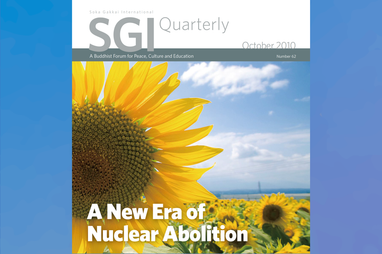SGI Quarterly

Takahisa Miyao, Soka Gakkai Student Division Leader, introduces results of a survey of attitudes among youth toward nuclear weapons.
From January to March 2010, student members of the SGI conducted a survey of attitudes to nuclear weapons in six countries (Japan, South Korea, the Philippines, New Zealand, the US, the UK), with interviews of 4,362 young people.
SGI Quarterly: What do you think this survey shows?
Takahisa Miyao: I believe that this survey has helped reveal how young people view nuclear weapons, one of the most formidable threats to humanity. The results show us that there is a persistent tendency for young people to think that the abolition of nuclear weapons is very difficult, even though a majority of them in most countries have strongly negative feelings about nuclear weapons. Almost 70 percent of respondents said the use of nuclear weapons was not acceptable under any circumstances. This is encouraging for us in our efforts to promote the adoption of a Nuclear Weapons Convention comprehensively banning these weapons of mass slaughter. Building on the widespread rejection of nuclear weapons by youth is key to efforts toward their abolition.
It was also clear that the more people have a concrete and detailed awareness of the threat posed by nuclear weapons, the more strongly they reject them. This speaks to the importance of informing people about the nature of nuclear weapons as a key means of strengthening public opinion for their abolition. The results of this survey have deepened our confidence that, by working to raise awareness among the members of our own generation about the horrors of nuclear weapons use, we can build robust public support for their abolition.
With the passage of time, the collective memory of what happened at Hiroshima and Nagasaki has begun to fade. We have responded by creating a five-language DVD recording the testimonies of hibakusha, nuclear survivors. The youth members of the Soka Gakkai in Japan also regularly create opportunities for people to hear the experiences of hibakusha.

Kenji Shiratsuchi, Chair of the Soka Gakkai Youth Peace Conference, presenting an antinuclear petition to Ambassador Leslie B. Gatan, adviser to the President of the NPT Review Conference.
SGIQ: Would you consider extending your survey to interview youth in all 192 UN member states in order to get a worldwide sample?
Kenji Shiratsuchi: We feel this survey gave a good snapshot of the views of youth around the world. So at this point, our priority goal is to make people more aware of the findings. For example, while a majority of young people want nuclear abolition, more than half also think this is impossible. We want to find ways of closing the ”hope deficit,” the gap between what young people think should happen and what they believe is possible. Over the long term, we want to continue to build global solidarity among young people for peace and nuclear abolition in creative ways and in collaboration with different civil society partners.
Survey Results*:

© Survey results, all rights reserved, Soka Gakkai
*In the original survey there were nine questions in all, and there were more options for responses. For the sake of brevity here we have reprinted only the affirmative and negative responses from the original survey.


